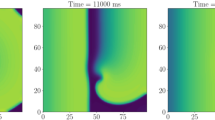Abstract
Regardless of how it is initiated, the final stage of sudden cardiac death is ventricular fibrillation (VF), a completely disorganized electrical activity of the ventricles, characterized by multiple reentrant circuits. There is only one known therapy for VF, a strong electrical shock, normally referred to as electrical defibrillation. In this study we investigate the hypothesis that the energy level required to stop fibrillation is dependent on the actual level of organization of the underlying reentrant activity. A three-dimensional bidomain model with unequal anisotropy ratios incorporating stochastic variations of the conductivity tensor was used. The active membrane behavior was described by the Courtemanche model of the human atrial action potential incorporating an acetylcholin (ACh) dependent K + current and electroporation. A spatial variation of [ACh] was used to obtain repolarization gradients allowing to control the degree of disorganization. Depending on the ACh settings, either a single rotor developed or spiral wave breakup evolving into fibrillatory like activity was observed. Shocks of varying strength and timing were delivered to both activation patterns and the probability of shock success as a function of shock strength was determined. Results indicate that arrhythmias with a higher degree of disorganization need significantly higher shock strengths to defibrillate.
Similar content being viewed by others
References
Aguel F, Debruin KA, Krassowska W, and Trayanova NA. Effects of electroporation on the transmembrane potential distribution in a two-dimensional bidomain model of cardiac tissue. J Cardivasc Electrophysiol, 10: 701–714, 1999.
Cheng Y, Mowrey KA, Van Wagoner DR, Tchou PJ, and Efimov IR. Virtual electrode-induced reexcitation. Circ Res, 85: 1056–1066, 1999.
Courtemanche M, Ramirez RJ, and Nattel S. Ionic mechanisms underlying human atrial action potential properties: Insights from a mathematical model. Am J Physiol 275: H301-H321, 1998.
Eason J, and Trayanova N. Phase singularities and termination of spiral wave reentry. J. Cardiovasc Electrophysiol 13(7): 672–679, 2002.
Keener J. The effect of gap junctional distribution on defibrillation. Chaos, 8: 57–64. 1998.
Kneller J, Zou R, Vigmond EJ, Wang Z, Leon LJ, and Nattel S. Cholinergic atrial fibrillation in a computer model of a two-dimensional sheet of canine atrial cells with realistic ionic properties. Circ Res 90: 373–387, 2002.
Knisley SB, Trayanova N, and Aguel F. Roles of electric field and fiber structure in cardiac electric stimulation. Biophys J 77(3): 1404–1417, 1999.
Mower MM, Mirowski M, Spear JF, and Moore EN. Patterns of ventricular activity during catheter defibrillation. Circulation, 49: 858–861, 1974.
Sepulveda NG, Roth BJ, and Wikswo JP. Current injection into a two-dimensional anisotropic bidomain. Biophys J 55: 987–999, 1989.
Skouibine K, Trayanova NA, and Moore P. Success and failure of the defibrillation shock: insights from a simulation study. J Cardiovasc Electrophysiol 11: 785–796, 2000.
Vigmond E, Aguel F, and Trayanova NA. Computational techniques for solving the bidomain equations in three dimensions. IEEE Trans Biomed Eng 49(11): 1260–1269, 2002.
Windisch H, Dapra D, Køhler H, MÜnzer T, and Janschitz M. Structure related membrane polarizations in field stimulated guinea pig papillary muscle. In Proceedings of the 23rd Annual International Conference of the IEEE Engineering in Medicine and BiologySociety, Oct 25–28, 2001.
Author information
Authors and Affiliations
Corresponding author
Rights and permissions
About this article
Cite this article
Plank, G., Vigmond, E.J. & Leon, L.J. The Shock Energy Required for Successful Defibrillation Depends on the Degree of Disorganization of the Reentrant Activation Pattern. Cardiovascular Engineering 4, 149–153 (2004). https://doi.org/10.1023/B:CARE.0000031543.38079.62
Issue Date:
DOI: https://doi.org/10.1023/B:CARE.0000031543.38079.62




